Document life cycle in professional help system. A little fabulous post about how a pile of paper turns into a system

Carlson's dream comes true
Remember from the classics:
- Carlson, you know, she wants to get on the TV!
- She is? In tv?
- Yes.
“This fat housekeeper wants to get into the smallest box ?!” Nothing happens. It will have to be folded four times!
')
Now imagine that every day we put in the “smallest box”, in the information and reference system, three real carts of text documents that weigh clearly more than Freken Bock. Plus, all these documents need to somehow get, check, many times, technologically process, and then deliver to the user in a reliable and up-to-date form. This Carlson could only dream of.
Today we will take a tour of the Production Department of the Consortium "Code" (PD), whose employees are engaged in the formation of the filling for professional reference systems "Code" and "TechExpert". Colleagues from different departments from the first mouth will talk about our method of "purity targeting" in a system of this magnitude. We follow the entire life of the document from search to contact with the user. Also find out if the document has a life after death.
Inside view

The Codex and TechExpert systems are professional reference systems with a fund of regulatory technical and legislative information of 13 million units (+ ~ 40 million documents of judicial practice). The program complex combines regulatory and consulting materials, as well as analytical services for working with documents.
Someone joked with us that the basement of the Codex has its own underground factory of gnomes, who work day and night for the benefit of the development of the system. Indeed, the volumes of incoming documentation and document support work are enormous: hundreds of copies get into the drawing system per month, so it would be nice to have such a fabulous resource. But in fact, the processing of documentation is the hard work of more than 120 real and wonderful people.
The specifics of the documents and their analysis
Our repository contains large blocks of technical standards (GOST, GOST R, SP, SNiP, GN, R, GESN, etc.) , regulatory and legal acts of public authorities (laws, decrees, decrees, bills, etc.) , technological documentation (drawings, diagrams, etc.) , analytical materials, classifiers and dictionaries, reference information. Not only the content of the information itself (the text of the document can be found on the Internet) is essential, but its status and relevance - whether the document is valid, and if it is valid - since what time, what were its predecessors, on the basis of which documents were changes made and .d For the system to perform such tasks, each document must be analyzed manually.
Processing process
The processing of the document varies depending on the type of documents. In a broad sense, we divide the documents into regulatory and legal (NP) and regulatory and technical (NTD). Technological stages of their processing resemble a conveyor. From point "A" the document moves to point "B", in the hands of the user, each of which follows its own route and is controlled at each stage. Let's tell about each of them.
1. Search for a document or life before birth
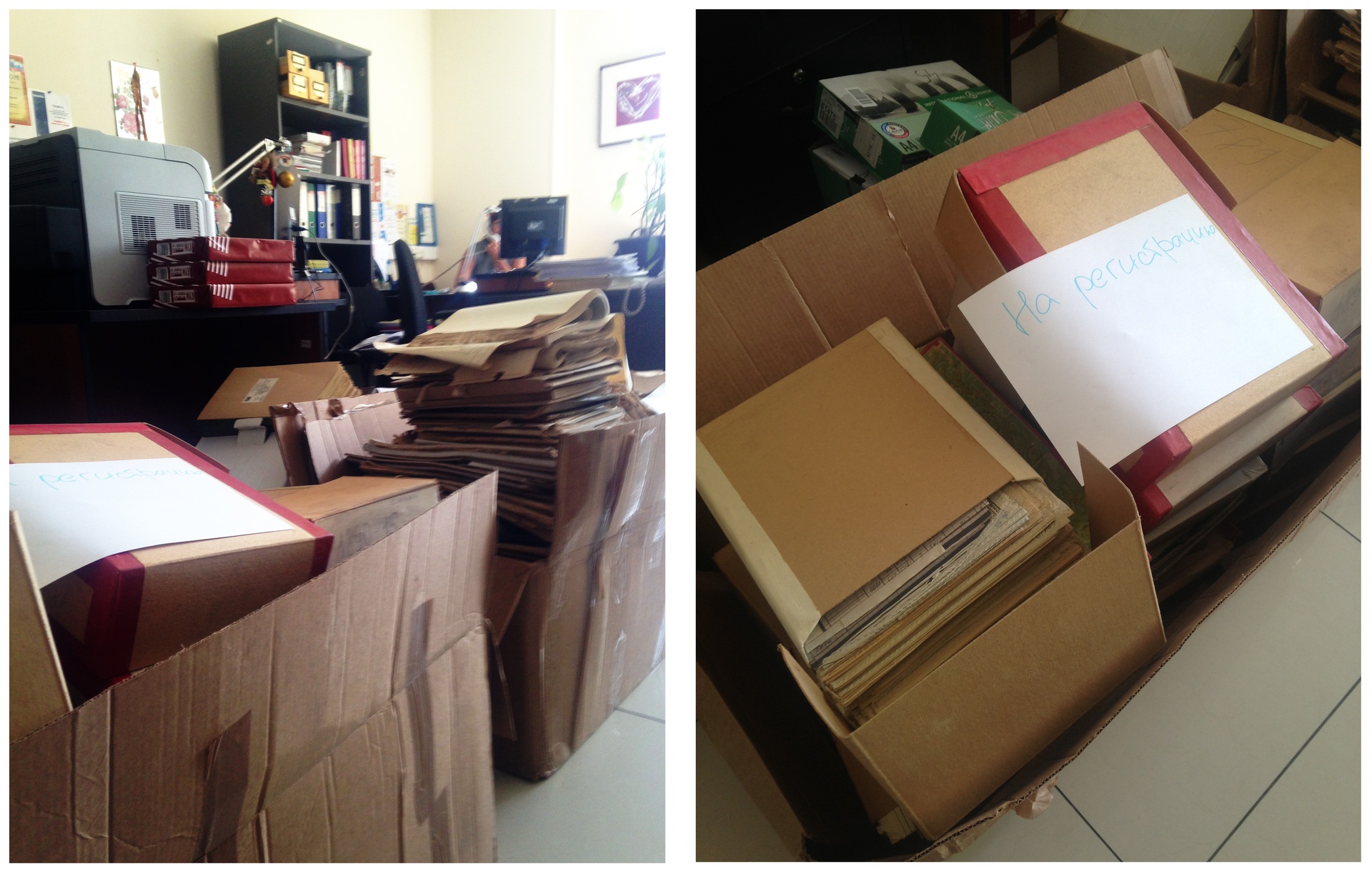
In order for a document to be included in the reference system, you must first find it. The world is ruled by public relations, so that almost all new documents, be it a change in legislation or in the field of technical regulation, come to us immediately. Most often, in paper form. It is terrible to admit, but we do load the documents with carts, and the typical office of the production department employee resembles the old man’s tower and a mountain of paper, from which only the ears of the responsible employee often stick out.
Almost every day, you can see all the important new documents in our system. And what about more specific instances? For example, with a rare SNiP or SP? Here it all starts with the Office of Information Support . Employees of this unit daily monitor huge layers of information from which they must select important and potentially interesting documents for inclusion in the system.
Here is the scheme of processing the document at the first stage was found in colleagues.

Where to find the document?
For each type of document has its own source of search. Often these are official sources of developers of professional documentation - if their sites contain an interesting document for users, we will definitely request permission to publish it in our system.
If we are talking about a regulatory document, here we will look for the necessary information in official sources of state authorities, print publications, government publications, etc. If we are looking for a technical document, we turn to design institutes, research institutes, etc.
We also have an established partner network - for example, the National Library of Russia, which regularly provides us with old documents. By the way, quite rare author's documents can be found in our systems. To do this, there is the Department of Information and Strategic Development , which negotiates with organizations and concludes licensing agreements with the authors.
In general, the Information Management Department monitors several hundreds of different sources in all industries.
One old is better than new two or how to get the unproduced

In the systems we add not only new, but also old standards. What for? Because they are necessary for specialists - architects, restorers or doctors, etc. It is difficult to imagine the progress of the reconstruction project without studying the original drawings.
And who would have thought that still very popular are retro documents from the Ministry of Health, which are very difficult to get? It turns out that many technologies and standards that were put into circulation at the dawn of the development of the industry still remain unchanged. Formally - old, in fact - relevant.
Especially for this work, we have our own “partisan detachment” in our company, which searches for such rarities and spends half of its working time in the archives. Order GOST from abroad, get the author's project documentation, if its developer has long died or (aerobatics!) To convince very Persistent Grandfather , a researcher, to issue the necessary copy? Almost everything is possible.
The main salt of this demanding work is to build effective personal connections, reach an agreement with the right source and get the unproduced. That's all :)
2. Initial analysis
Hooray! We found the "same" document. Now we must check for the relevance of the original and all the information that is available on it.
If this is a regulatory and technical document, then we will know its status - whether it works or not, as well as how much has changed in its “life”, where it was previously published and in what form it should appear in our system - in full text or as a scanner Copies, and maybe both.
If we work with a regulatory document, we also clarify all the important parameters.
We record the collected information on any type of document in a special accompanying sheet. Together with a paper copy of the document, we will transfer this sheet further along the technological chain. We mark in which sections of which databases the document should be included - our colleagues at the other end of the chain will put the corresponding base in a drawing informational product that will go to the user.
By the way, it also happens that we find some rare document that makes it impossible to determine its relevance and status. Since the material can theoretically be useful to the user, we still load it into the system, however we make a note that in this case, when accessing the document, the user should see the corresponding warning.
Now we have to register the document in our internal working database and send it for further processing.
While the document is being registered, we enjoy the view from the window.
3. Before inclusion in the system. Deadly force eliminates illegal immigrants
The preparation of our document - the printed text with the accompanying sheet - now falls into the Office of Basic Information Processing (UBOI) , the departments of processing regulatory, regulatory or regulatory information. Here our best "operatives" are already waiting for him.
Now the responsible specialist will create a special document card - a kind of “passport”, which will be assigned to the document throughout its existence in the system. Immediately the document will be given a unique ID number, will indicate its category, type and section. Now our document is officially no longer “illegal”, which means that it is already on its way to getting into the system.
We put the newcomer on the "route". He will have to get into the hands of four more different specialists.
4. Packing and reconciliation
Regulatory Legal Document
At this stage, we translate the paper original into an electronic form.
For this, the legal document is scanned and recognized. The received electronic text is issued in accordance with the standard of the enterprise. After that, the document is printed and carried to the verification of proofreaders. It is important to go through the eyes of each line, because when recognizing the text could be technical errors.
On average, specialists in stuffing and reconciliation process more than a kilometer of printed text per year! Photo to assess the scale of the disaster. The color of the folder containing the document indicates how urgent it is to be processed.
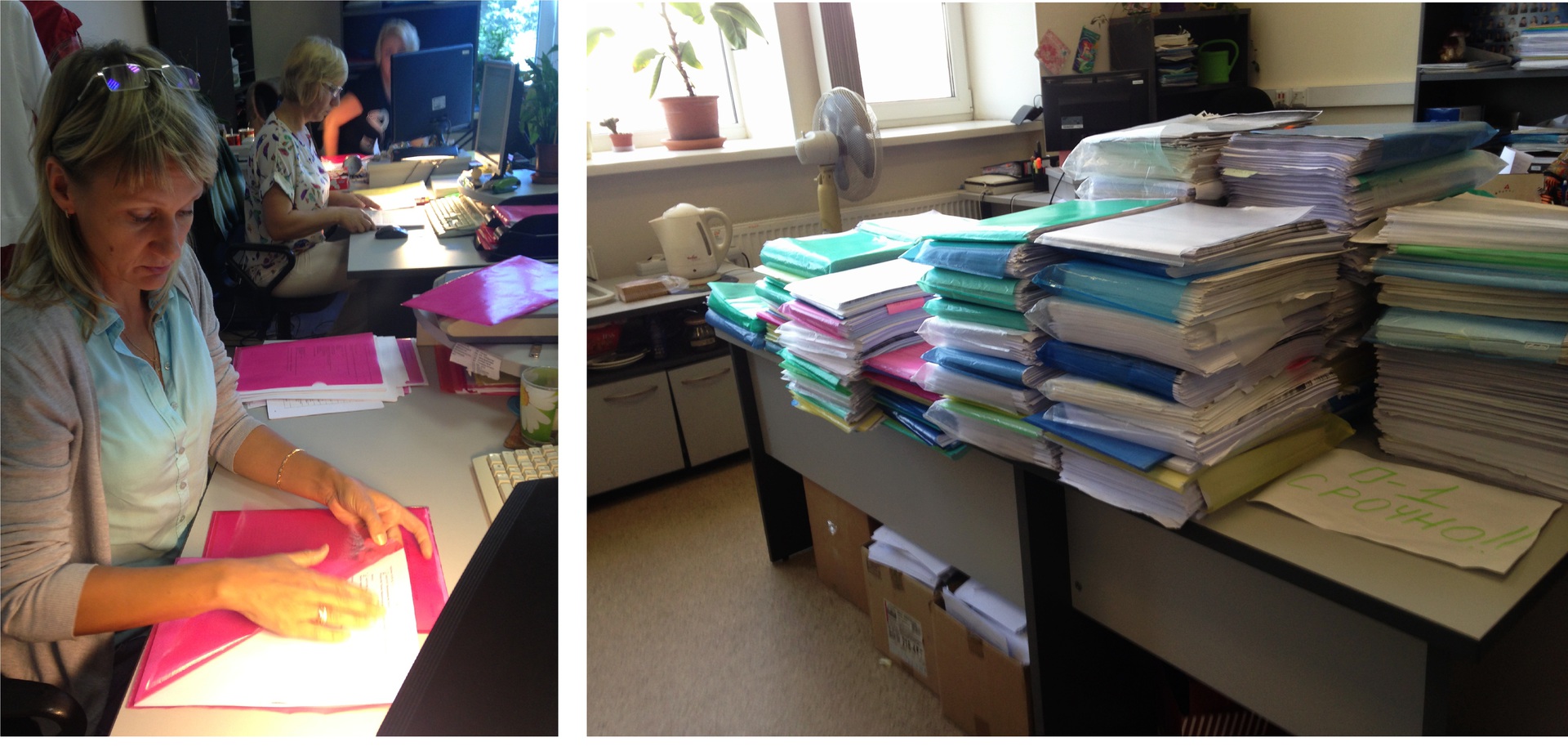
Regulatory Technical Document
The regulatory technical document is processed in the same way, but there are nuances, because along with the printed text we process drawings, layouts, tables and other accompanying materials. For such a document, we always create a scanner copy - confirmation of the highest accuracy.
Before you become a scanner-copy, the image passes the stage of graphics detuning. If the graphic element is simple, then we include it in the system without any problems. If we are talking about a complex drawing, an extensive scheme, or some document that has been in archives for many years, then here a whole team of specialists is working on its quality and readability.
The full-text version of the NTD is also displayed in the system: this is necessary so that all analytical services are accessible to the user.
At the same scanner-copy of the document associated with his card.
The scanner-copy remains to lie in the technological base, and we also carry the text on proofreading verification.

5. From proofreading reconciliation - to the top
After proofreading, each document returns to the stuffing stage. There he will be met with joy and will correct all inaccuracies that could accidentally sneak into the text. At the same stage, the electronic document and all the drawings are attached to the document card, to his “passport”. Now we can see the document almost as a user will see it after some time. Again we print out the text of the document already “from the system”, we carry proofreaders (yes, again !!), which read the document “finger-to-finger”.
In the photo - the work of proofreaders.
6. Script processing
At this stage, database operators work with text. They are responsible for ensuring that all service opportunities for working with the document provided by the system are available. For these operations, the corresponding scripts are used.
Of the important points - we arrange hyperlinks and check whether they all work correctly.
Some hyperlinks are responsible for the relationship between documents within the system: documents can refer to each other, and refer either to the beginning of the document or to a specific section of the text.
Another type of hyperlink is responsible for navigating through the document being studied and provides a transition to the item or section mentioned in the text.
The third type of hyperlink will lead to external sources, such as sites, as well as reference materials in our systems, etc. All this needs to be arranged and check the correctness of the work of the aligner scripts and anchors.
Here we add styles to the document, a hierarchically expandable table of contents by which you can search. We clarify whether the system understands the status of the document, the changes planned in it, and so on ... In a word, we are looking for everything to work.
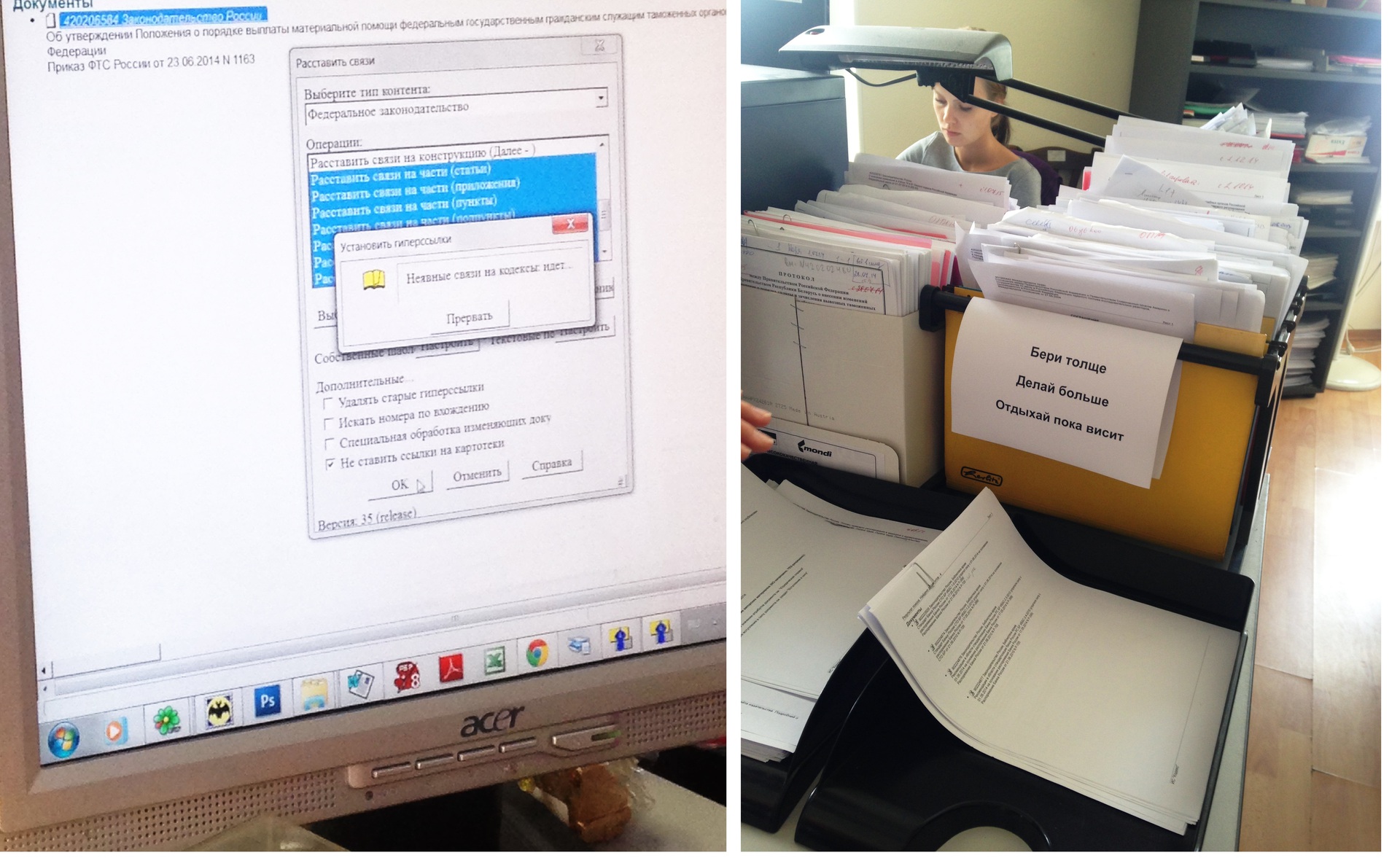
In turn, the user must get their own capabilities to work with the document - for example, get a link to it in a third-party application, upload the text to their computer, access the pop-up hint, put the document under control, etc.
It is necessary to understand that technical means can not always correctly recognize, for example, cases, so again we read the text very carefully.
Check if everything is in order. Hyperlinks placed correctly:

We look in the system. There was an information line, hyperlinks also work. So we can go further:
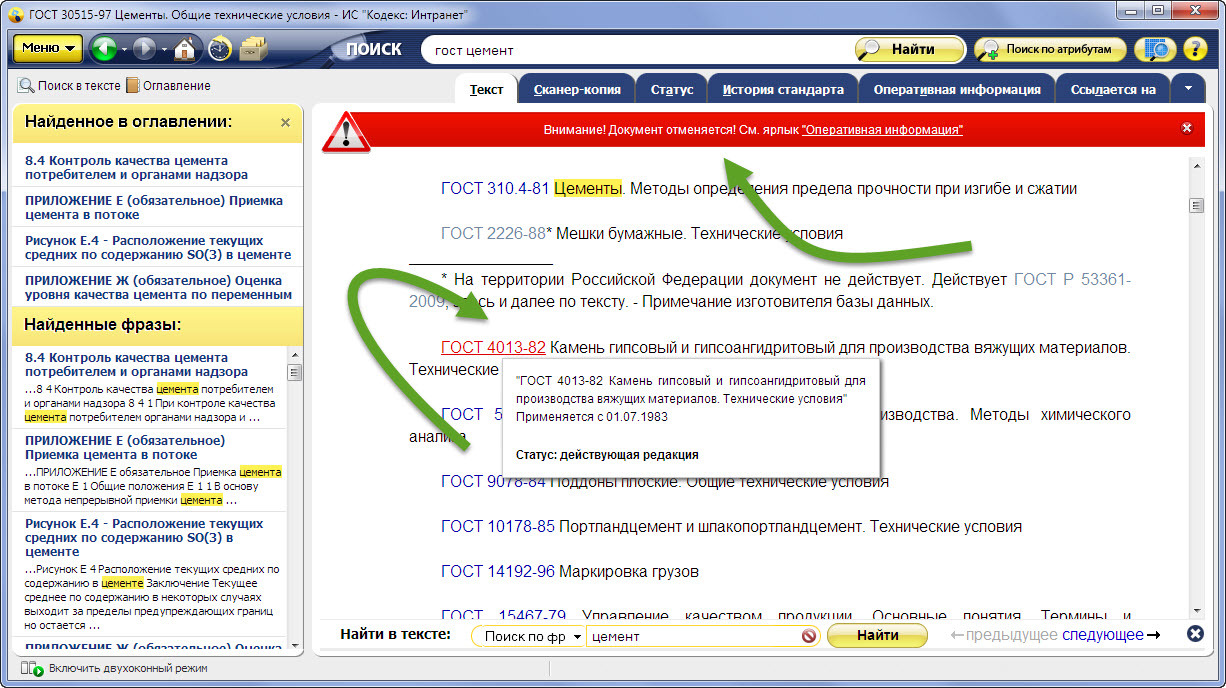
Specify the status of publication - who, when and where it published - and put it in the database for further processing.
7. Legal verification and sending packages of documents to users
Did you think everything? Not! Now our lawyers will check all information lines, document statuses and other information for compliance with the originals. Now the document - fresh and beautiful - lies in our technological base. With peace of mind, we give it up for copying by volumes. Our document, together with its congeners, will be packaged on thematic bases and on information products, and then given to users.
It turns out like this:

8. Updating
At this stage, the processing of the document does not end, since in the future it is necessary to maintain its relevance. In preparing the new documents, the lawyer should pay attention to whether the new documents in some way change some old copies that are already included in our database. Such changes may include changes in legislation, amendments, renewal and suspension of action, clarification of the application and cancellation of the document.
These are so important components that we provide the user with information about them right on the same day — he will receive it along with the next update of the databases. But he has not yet seen the new text.
After the information about operational changes in the system has been sent, the actualizer-analyst is taken for the text of the document. He will create a new or future revision of the document, change the text in accordance with the changing document, prepare for the document the “Comparison of revisions”, “Review of changes”, “Clean texts” services .
The “Review of Changes” will show what has changed in the current edition compared to the previous one. The service “Comparison of revisions” will allow a comparison of any revisions of the document to each other: the system will highlight all the changed wordings, so it will be easy for a specialist to work with them. For example:
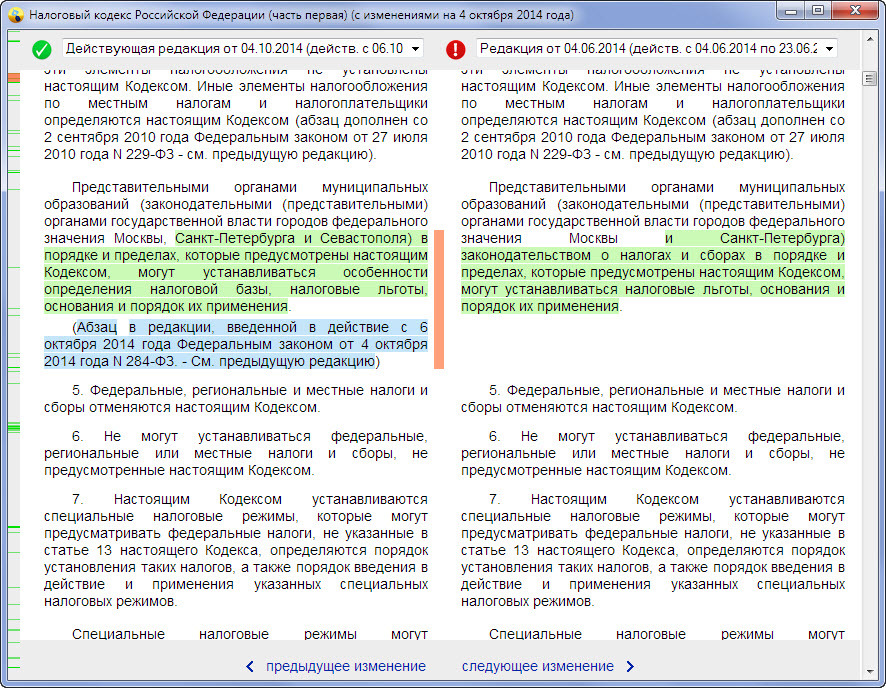
Both federal and technical legislation are often subject to change. In this regard, the texts of the documents contain a large amount of explanatory materials. With the help of the service "Clean Texts" you can get the text of the document, free from such notes, which is convenient when reading and printing a document.
When will the user see the document?
As soon as all previous stages of processing are completed, not one, but immediately a selection of all new documents gets into a daily, weekly or monthly update.
The frequency of updates is determined by the dynamic content change and user needs. This means that after updating at system startup, the user will be able to receive this document. Especially for those who do not want to wait, new documents on the results of the day can be found in the “Hot Documents Online” service. There we put online versions of documents that are intended for wide viewing.
Is there death after life?
In fact, if a document once in a lifetime has entered the system, it will never disappear from there, so the answer is “no” :) Only changes can be made - in strict accordance with our internal regulations. The status of the document, its card and internal wording may change, notes and comments will be added, but the document itself will always be available, even after loss of force.
And finally
Today we met with some of the work processes of the Production Department. Now you yourself know how many hands a single document passes before getting “on the table” to the user.
It is very important to note the contribution of each employee to the coordinated work on the construction of the system, as well as the degree of his personal responsibility. The final product will go to users - this is more than 150 thousand companies that trust us. These are millions of professionals and millions of situations, for each of which the system must provide the most competent solution.
In future publications we will continue to talk about our work. Already not only about documents, but also as a whole about our methods of data organization in professional help systems.
See you again!
Source: https://habr.com/ru/post/243439/
All Articles